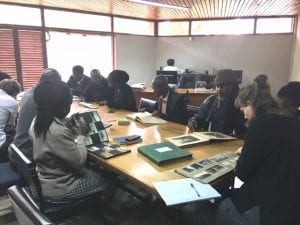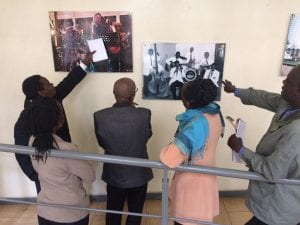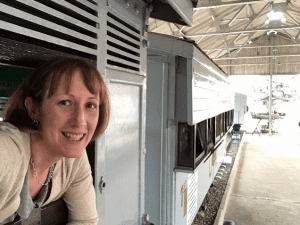Nairobi: The Building Shared Futures project
Posted on by Fay Curtis.
by Nicky Sugar, archivist of the British Empire and Commonwealth Collection
Last year we reported on a research trip to Kenya by Dr Liz Haines and Dr Neil Carrier of the University of Bristol. They made contact with academics and curators in Nairobi to explore the research potential of photographs in the British Empire and Commonwealth Collection (BECC).
As a result, the Building Shared Futures (BSF) project was born!
The aim of this project is to consider how digital technology can help us to share historical image collections between the UK and Kenya. We believe that digitally repatriating photographic archives can increase social justice, by enabling citizens to participate more fully in writing the past of the city and imagining its potential futures.

Sharing material in Kenyan archive collections
The BSF team met for the first time in early April, when six Kenyan visitors travelled over for a workshop. We spent time sharing the huge amount of Kenyan material held here in Bristol Archives and identifying gaps in material held in Kenya from the pre-independence era.
To fill these gaps, our Kenyan colleagues helped us to prioritise over 2,000 images they would like to see digitised. By the end of our time together we’d also hatched a rather ambitious plan to launch the project in Kenya with an exhibition, co-curated across two continents in just eight weeks!
Three of us – Neil, Liz and myself – then travelled to Nairobi in June. It was my first visit to Kenya and there were many highlights.
My highlights included:

BSF team collaborating on captions for the exhibition
– Visiting Nairobi landmarks, and listening to the stories of the city told by archivists, lecturers, creative practitioners and a community leader from a historic estate threatened by developers.
– Looking at archive collections in the National Museum of Kenya and the University of Nairobi. We discovered many overlaps with material we hold here in Bristol. Once images from these collections have been digitised, we aim to produce a digital resource where photos can be uploaded to an interactive map. This will allow people to explore the history of their capital city on the move.

On an original Uganda Railways train!
– Putting the final touches to our exhibition, which is now open at the National Museum of Kenya. Ten images of life in 1950s Nairobi from the BECC were chosen alongside responses from a contemporary Kenyan photographer. We already have two other venues in Kenya who want to display it. We’ll also be showing the exhibition here at Bristol Archives in September.
– Visiting the Railway Museum. Home of the East African Railways & Harbours archive for which we also hold a large amount of material. We discussed copyright issues as well as inviting their curator to join the BSF team.
What next?
By our final session we had developed a plan for the next phase of the project. This will include more digitisation from a range of organisations, research studentships, the launch of our map website and an ambitious programme of community engagement.
My week in Kenya showed me that there is a strong appetite for greater access to material from the colonial period. Photographs in particular are in demand for research, community development and helping to develop narratives around Nairobi’s 120 year history.
The resources available from this type of partnership can also boost infrastructure in Kenyan heritage institutions. All of us felt that we were at the beginning of something really exciting: we look forward to the next phase!
One comment on Nairobi: The Building Shared Futures project
Wonderful! I’m so pleased to read your take on Nairobi – my birthplace and home for nearly 30 years! of life. My family were part of the Railways”creation of Kenya” from 1896 when my Grandfather joined the then Uganda Railway (Lunatic Express) as a clerk and then became first Station Master of Port Florence – the railhead which became Kisumu. Both my father and his brother joined the KUR&H as graduates with AIMec E – my father to become Chief Draughtsman, Mechanical Engineers Department, and my uncle as boss man of the foundry, Nairobi workshops. I broke the mould and became (first) a medical laboratory technician, then (finally) a university technician involved in fish science and research! However, the UR, KUR&H and EAR&H will always be part of me.